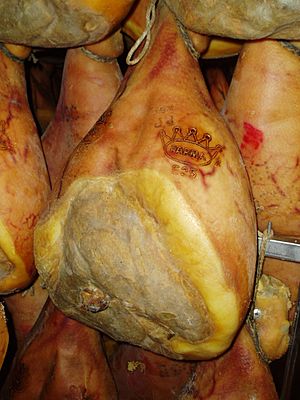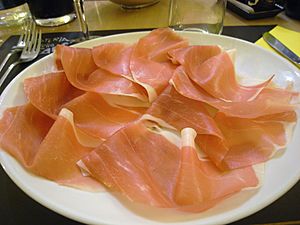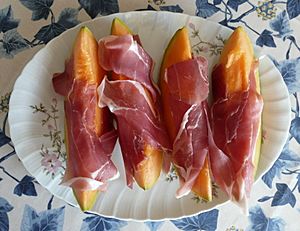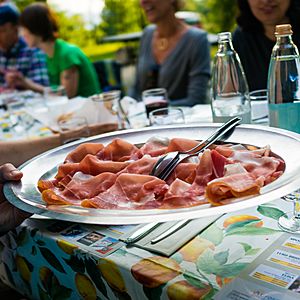Prosciutto facts for kids

Prosciutto di Parma PDO
|
|
| Course | Antipasto |
|---|---|
| Place of origin | Italy |
| Similar dishes | Jamón serrano |
Prosciutto crudo, often just called prosciutto in English, is a special kind of ham from Italy. It's uncooked, not smoked, and is preserved by being dry-cured with salt. People usually serve prosciutto cut into very thin slices.
Different parts of Italy make their own types of prosciutto crudo. Many of these have a special "protected status" to show where they come from and how they are made. The most famous kinds are Prosciutto di Parma from Emilia-Romagna and Prosciutto di San Daniele from Friuli Venezia Giulia. Unlike another Italian ham called Speck, prosciutto is never smoked.
In Italy, the word prosciutto simply means "ham." This can be dry-cured ham (prosciutto crudo) or cooked ham (prosciutto cotto). But in countries like the U.S. or U.K., when people say "prosciutto," they usually mean the Italian dry-cured ham.
Contents
What Does "Prosciutto" Mean?
The word prosciutto comes from old Italian words that mean "to dry thoroughly." It's related to the Italian word prosciugare, which means "to dry out completely." This makes sense because prosciutto is a dry-cured ham!
How Is Prosciutto Made?
Prosciutto is made from the back leg of a pig. The process takes a long time, usually from nine months to two years, depending on how big the ham is.
First, the pig's leg is cleaned and covered in salt. It stays like this for about two months. During this time, the ham is gently pressed to remove any leftover blood.
Next, the ham is washed several times to get rid of the salt. Then, it's hung up in a dark place where air can move around well. The air in this place is very important for how the ham will taste. The best prosciutto comes from places with a cool climate.
The ham hangs until it's dry. How long this takes depends on the weather and the size of the ham. Once it's completely dry, it's hung again to air-cure for up to 18 months. This can be at room temperature or in a special controlled room.
Some types of prosciutto use nitrites (special salts) to give them a pink color and unique taste. However, the most famous and protected types of prosciutto, like Prosciutto di Parma, only use sea salt. The pink color in these hams comes from a natural chemical reaction as the meat dries.
How to Enjoy Prosciutto
Sliced prosciutto crudo is often served as an antipasto, which is a starter dish in Italian meals. You might see it wrapped around grissini (thin breadsticks) or served with sweet fruits like melon or figs.
It's also eaten with cooked spring vegetables, such as asparagus or peas. Sometimes, it's added to a simple pasta sauce with cream. In Tuscany, it might be part of a dish with tagliatelle pasta and vegetables.
Prosciutto is also used in many other ways:
- As a stuffing for other meats, like veal.
- Wrapped around veal or steak.
- Inside a filled bread.
- As a pizza topping.
A famous Italian dish called Saltimbocca uses prosciutto. It's made with thin slices of veal topped with a sage leaf, then wrapped in prosciutto and pan-fried. Prosciutto is also popular in sandwiches and panini. Sometimes, it's even added to a Caprese salad with basil, tomato, and fresh mozzarella cheese.
Special Italian Prosciutto Names
The European Union (EU) has special rules to protect the names of certain traditional foods, including some types of prosciutto. This means that only prosciutto made in a specific way and in a specific place can use these protected names. This helps customers know they are getting a real, high-quality product.
The two most famous types of Italian prosciutto crudo are:
- Prosciutto crudo di Parma: This comes from Parma. It sometimes has a slightly nutty taste because the pigs might eat whey from Parmigiano Reggiano cheese.
- Prosciutto crudo di San Daniele: This comes from the San Daniele del Friuli area. It's usually darker and tastes sweeter.
For both of these famous hams, the rules say that only salt can be used to cure the meat. They are not allowed to use other additives like nitrites, which are sometimes used in other hams.
Here are some other Italian prosciutto varieties with protected names in the EU:
- Prosciutto di Parma, Parma, PDO (Protected Designation of Origin)
- Prosciutto di San Daniele, San Daniele del Friuli, PDO
- Prosciutto di Modena, Modena, PDO
- Prosciutto toscano, Tuscany, PDO
- Prosciutto Veneto Berico-Euganeo, Veneto, PDO
- Prosciutto di Carpegna, near Carpegna, Montefeltro, PDO
- Prosciutto amatriciano, near Amatrice, Lazio, PGI (Protected Geographical Indication)
- Prosciutto di Norcia, Norcia, PGI
- Prosciutto di Sauris, Sauris, PGI
- Crudo di Cuneo, Cuneo, PDO
- Valle d'Aosta Jambon de Bosses, Val d'Aosta, PDO
Culatello: A Special Ham Cut
Culatello con cotenna is a type of ham that is similar to prosciutto but is made from a different part of the pig's leg, called the filet or loin. It's aged inside a casing made from a beef or pig bladder to keep it safe. Culatello di Zibello is a famous type of Culatello that also has a protected status. It's often served as a starter.
Strolghino is a type of salame (a cured sausage) that is made from the leftover pieces of meat when making culatello.
Pršut: Ham from Other Countries
In some countries like Montenegro, Bosnia and Herzegovina, Slovenia, Serbia, and Croatia, there's a similar dry-cured ham called pršut. Some types of pršut, like those from Dalmatia, are smoked, which is different from Italian prosciutto. Others, like those from Slovenia, are not smoked.
Here are some types of pršut that have protected status in the European Union:
| Country | Area | Name | Type of Protection | Year Registered |
|---|---|---|---|---|
| Croatia | part of Dalmatia | Dalmatinski pršut | PGI | 2016 |
| Croatia | Šibenik-Knin County | Drniški pršut | PGI | 2015 |
| Croatia and Slovenia | part of Istria | Istarski pršut / Istrski pršut | PDO | 2015 |
| Slovenia | part of the Kras | Kraški pršut | PGI | 2012 |
| Croatia | Krk | Krčki pršut | PGI | 2015 |
See also
 In Spanish: Prosciutto para niños
In Spanish: Prosciutto para niños







